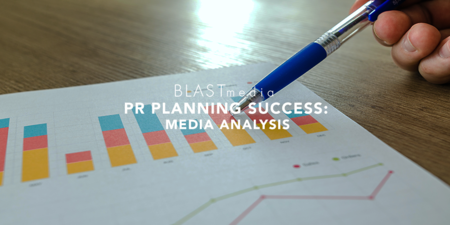So you have decided to look into new ways to reach your audience, customers, and investors through public relations, but where to begin? When kickstarting your PR planning, implementation, and evaluation efforts, research should be at the forefront of every great strategy. Rather than an unending loop of trial and error campaigns, taking the time to conduct research can be the make or break of your PR efforts. With proactive and strategic methods, PR initiatives can and should thrive.
In order to execute successful PR planning, understanding the role research has in developing those strategies can play a key factor in determining next steps. There are many different types of essential research, but the one I want to focus on today is media analysis.
A media analysis provides valuable insight into what is currently happening in the media landscape — and what competitors are talking about. Having this information can help guide and build the best PR strategy for inserting thought leaders into conversations.
First things first: media analysis
PR planning is fun and exciting, making it easy to want to dive into brainstorming ideas and campaigns right off the bat. However, it is important to take a step back and gain perspective on key market players and the conversations they are having in the media. By doing so, goals and strategies can be better aligned. Instead, starting with a media analysis prior to planning and implementation can provide crucial information, such as what kind of stories are being written, which reporters and publications are writing about similar topics or stories, and who is covering competitors. This can include an assessment of many things:
- Share of Voice measures the percentage of all online content and conversations about your company or brand, compared to those of your competitors. Share of Voice is a great tool for understanding how much coverage you are receiving compared to competitors, however, it does not provide a representation of the quality of coverage received.
- Media mix consists of the make-up of a company’s different types of coverage including contributed content, features, quotes, mentions, and press release postings. We recommend a mix of 50% news, 25% contributed content, and 25% interviews and quotes from subject matter experts.
- Press release strategies include a sound cadence of announcements to show consistent innovation and growth. These strategies can consist of product announcements, executive additions, fundraising, customer wins, original data and more.
- Spokespeople are the company executives who will be sharing their thought leadership expertise with the media. Their titles, experiences, and bold ideas help stand out against others in the industry and build up a brand.
- Website impact can be analyzed through an assortment of metrics such as domain authority, potential reach, backlinks and website sessions driven by articles. Understanding impact better determines underlying strategies for outreach and media placements.
At BLASTmedia, we provide a media analysis as part of our research process. Our new client onboarding includes an analysis of their media landscape prior to beginning our PR strategy and efforts. When conducting this research, we take a look at all of the above assessment topics from share of voice to website impact for both our client and each individual identified competitor. Breaking down each facet of their media strategies can help us determine where our clients stand in relation to their competitors and set realistic expectations and goals for standing out and driving thought leadership. In doing so, we come across key findings that impact our overarching PR strategy. For example, if competitors are focused on a cadence of press releases but with minimal thought leadership campaigns, our team can plan announcements in-tandem as well as prepare unique and bold angles to fill the thought leadership gap in the industry that competitors are lacking.
Also with our media analysis, BLASTmedia is able to take a deep dive into the different publications and reporters for specific verticals. For example, we don’t want to reach out to the New York Times education writer about healthcare technology, do we? If one competitor is gaining traction in a specific vertical or publication, we use this knowledge to see how we can also best reach out to those writers. Knowing what they cover and trends in their writing we are able to insert our clients into the conversation. Additionally, taking the time to research competitors and the industries they are in as a whole helps us better understand our clients, build thoughtful campaigns that speak to their audiences, and overall execute on the needs of our client.
By analyzing this information, one gains a holistic view of the media landscape. In turn, this helps guide the PR planning process and develop an educated and effective PR strategy moving forward.
Challenges of media analysis
Effective media analysis requires an understanding of who is writing what, when and how you can fit into their cadence of storytelling. Simply looking at coverage is insufficient in providing the necessary information for effective PR planning. Instead, analysis and application of information is what uncovers opportunities and drives successful initiatives. A media analysis can be tricky, as all of this information is open to interpretation. There are no formal quantitative methods of conducting a media analysis; it relies on subjectively looking at the company, competitors and the stories being told.
Additionally, analysis is not a one and done effort. The media landscape is constantly changing as new stories, writers and publications pop up every day. An initial media analysis before the PR planning process is crucial, but it is just as important to continually research, explore, and evaluate new opportunities.
At BLASTmedia, media relations and securing meaningful coverage is our priority. As each client is different, so are the opportunities with media. We prioritize understanding the media landscape prior to building a PR strategy to better educate ourselves and our clients on goals and expectations and best prepare them for PR planning initiatives.If you want to learn more about BLASTmedia and our dedication to educated and impactful PR strategies, contact Lindsey Groepper.



